| The Callington Branch An Introduction to the Signalling |
|||||||
|
|||||||
This page provides a general introduction to the Signalling of the former Callington Branch railway line. Other pages on signalling topics cover the signals, signal-boxes and ground-frames in more detail. Please click here for an Index to all Callington Branch pages in RailWest.
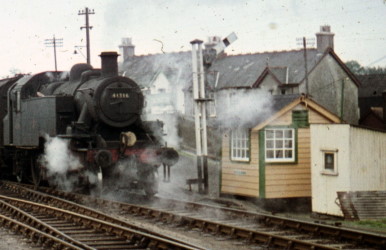 |
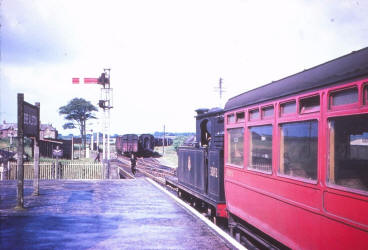 |
The East Cornwall Mineral Railway (ECMR) had a rudimentary form of signalling, which was described by JT Burge (one-time stationmaster at Templecombe station on the London & South Western Railway (L&SWR)) in an article published in the February 1908 issue of Railway Magazine. The single line from Kelly Bray to Incline Station at Calstock was worked on the 'time interval' system, combined with the single-needle telegraph. There was a passing loop at Cox's Park and it was possible also for trains to pass at West of England siding near Drakewalls, but as there was no agent at the siding written orders were issued to each driver not to leave the siding until the arrival of the train from the opposite direction. The line was regarded as being 'Down' from Kelly Bray to Calstock.
Semaphore signals were provided at Cox's Park, Monks Corner and Kelly Bray, although Burge states that these appear to have been used only when both engines owned by the ECMR were in steam on the line at the same time! Only Distant and Home signals were provided and these were of the 3-position slotted-post variety, which Burge says were of the "customary two-wire pattern". This appears to have been a pattern of signal where the arm was pulled by wire both to the 'off' and 'on' positions when the lever was pulled or pushed. There were seven public level-crossings, four of which were manned by gate-keepers, but no signals were provided and no lights were allowed to shine in the direction of the railway from the gatekeepers' houses between sunset and sunrise.
During the 1908 reconstruction the signalling was upgraded to a suitable level for a Light Railway. The entire branch was inspected for the Board of Trade (BoT) by Major JW Pringle on 5-February-1908 and much useful information can be found in his Inspection Report. Signal-boxes were provided at a number of locations, although these were in effect just ground-level lever-frames housed in simple wooden huts, usually with the block apparatus in the station office. Home and Starting signals were provided where required, but no Distant signals were fitted originally. (However one distant signal was installed at Gunnislake in 1938 as a result of a change in signal sighting and another was erected at Bere Alston in 1968/9, probably for the same reason.) The direction of working was changed, the line now being 'Down' from the junction at Bere Alston to the terminus at Callington.
The contract for the signalling work was let to FA Atkinson and EC&J Keay, but unfortunately it has not been possible to determine what components they supplied or to what designs. Early photographs are scarce, although the signals appear to have been lower-quadrant (LQ) arms on wooden posts similar to contemporary L&SWR practice. In later years many signals were replaced by the Southern Railway (SR) as upper-quadrant (UQ) arms on rail-built posts, although both the Down Outer Home and Down Inner Home at Calstock were rare examples of a LQ arm on a rail-built post. At Gunnislake in British Railways days there was a lattice-post signal and another which had a concrete post. Click here for further details on the signals. All the points were fitted with 'economical' Facing Point Locks (FPLs), a common method of economy on minor railways whereby the FPL and point were worked by the same lever. At the various loops the FPLs were provided with 34' locking bars and the signals were detected. In later years most of the points were refitted with ordinary FPLs, worked from separate levers.
Because of the numerous sharp curves and steep gradients the line speed was not very high; there was an overall maximum limit of 25mph, with numerous more severe restrictions. There were several un-gated level-crossings and the Light Railway Order required that speed be reduced to 10mph at 300 yards from each crossing. In some places the railway company itself imposed a more severe restriction because of the local situation. During the late-1920s the Southern Railway tried, but failed, to get approval to shorten the restricted distance to 200 yards. During their investigations they found that, in any case, many of the warning boards were not out the full distance from the crossings, but it is not clear what action (if any) was taken. Since the truncation of the branch at Gunnislake in 1966 the only public road level-crossings to remain in use are those at Okeltor and Sandways, both of which are located between Calstock and Gunnislake; all trains are required now to stop before proceeding over these crossings.
Signal Boxes and Ground Frames
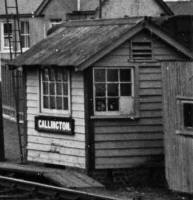 Signal Boxes were provided in 1908 at Bere
Alston, Calstock, Gunnislake, Luckett
and Callington stations. These were basically simple ground-level wooden
huts containing a lever-frame, the block working equipment being kept in the station
office. Click here for further details about the
individual locations. All the Light Railway signal-boxes are now closed and demolished,
although at Bere Alston the disused former L&SWR main line
signal-box still exists in a reasonable condition.
Signal Boxes were provided in 1908 at Bere
Alston, Calstock, Gunnislake, Luckett
and Callington stations. These were basically simple ground-level wooden
huts containing a lever-frame, the block working equipment being kept in the station
office. Click here for further details about the
individual locations. All the Light Railway signal-boxes are now closed and demolished,
although at Bere Alston the disused former L&SWR main line
signal-box still exists in a reasonable condition.
There were also a number of Ground Frames, mostly at intermediate sidings. Click here for further details about the individual locations. None of those ground-frames now remain in existence on the branch, although a ground-frame has existed at Bere Alston since 1970 to control the revised junction.
A proper form of Absolute Block working was introduced with the opening of the Light Railway in 1908 and the Board of Trade Inspection Report lists the single-line block sections as follows:
| BERE ALSTON - CALSTOCK | Train Staff & Ticket (TS&T) | |
| CALSTOCK - GUNNISLAKE | Electric Train Tablet (ETT) | |
| GUNNISLAKE - CALLINGTON | Train Staff & Ticket |
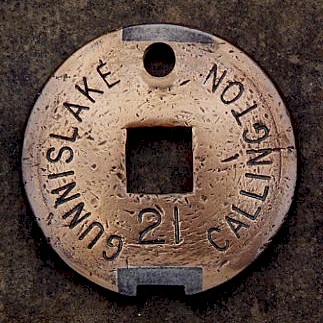 By 1911 the
ETT equipment is recorded as being Tyers No 7 instruments. A further
Inspection of new works in 1916 records that the GUNNISLAKE
- CALLINGTON section had been changed to ETT, with an intermediate
instrument at Luckett, and in 1923 this section is recorded as Tyers No 7 also ('B'
configuration). The picture shows one of the brass No 7 tablets from that section.
By 1911 the
ETT equipment is recorded as being Tyers No 7 instruments. A further
Inspection of new works in 1916 records that the GUNNISLAKE
- CALLINGTON section had been changed to ETT, with an intermediate
instrument at Luckett, and in 1923 this section is recorded as Tyers No 7 also ('B'
configuration). The picture shows one of the brass No 7 tablets from that section.
It has not been possible to establish what form of block instrument (if any) was used in conjunction with the original TS&T working. It is unclear also why there was just a single section of ETT working initially, especially as it was not the section with the most intermediate sidings, but perhaps it was provided to increase operational flexibility. In 1931 the BERE ALSTON - CALSTOCK section was listed in Southern Railway records as having a round train staff with green tickets, but it has been suggested by a former railwayman from the branch that in BR days the tickets were blue and that the staff working was controlled by telephone without any block instruments.
Fortunately the train staff and both ticket boxes (one from Bere Alston and the other from Calstock) have survived. (The staff and the Bere Alston box are now in the Colonel Stephens Museum at Tenterden in Kent.) The staff was a long metal rod (rather like a poker) with a circular handle at one end, which was inscribed "Go On To Bere Alston" on one side and "Go On To Calstock" on the other side. The ticket boxes were wooden and measured 12½ x 8 x 5½ inches, with a large brass plate 9¾ x 3 inches on the front bearing the section name. The boxes were unlocked by inserting the train staff into a keyhole in the right-hand end. The box from Bere Alston was painted red (but shows signs of having been blue originally), while the Calstock box was painted green; this variation in colours may indicate that this had been one of those TS&T sections which used different colour tickets for the opposing directions of travel.
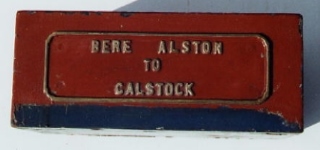 |
Train Staff and Ticket Boxes from the Bere Alston - Calstock block section |
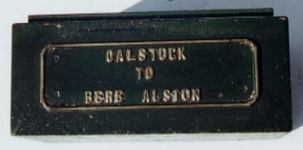 |
||
 |
||||
 In British Railways days the CALSTOCK -
GUNNISLAKE section was converted to Electric Key Token (EKT) working
on 3-March-1952, using the Western Region (WR) style of equipment with alloy key-tokens (believed to be 'A' configuration). Ten years
later the GUNNISLAKE
- CALLINGTON section was converted to EKT on 23-September-1962, but this time using the
Southern Region pattern of brass key-tokens ('B' configuration) - click here for
larger image. The BERE ALSTON - CALSTOCK section is believed to have
remained TS&T until 5-May-1968, when Calstock and Gunnislake
signal-boxes were closed, after which BERE ALSTON -
GUNNISLAKE became a single section with One Engine in Steam (OES)
working using a round, red wooden train staff of WR pattern. This
staff survives in the Museum collection of the
South Devon Railway at Buckfastleigh.
In British Railways days the CALSTOCK -
GUNNISLAKE section was converted to Electric Key Token (EKT) working
on 3-March-1952, using the Western Region (WR) style of equipment with alloy key-tokens (believed to be 'A' configuration). Ten years
later the GUNNISLAKE
- CALLINGTON section was converted to EKT on 23-September-1962, but this time using the
Southern Region pattern of brass key-tokens ('B' configuration) - click here for
larger image. The BERE ALSTON - CALSTOCK section is believed to have
remained TS&T until 5-May-1968, when Calstock and Gunnislake
signal-boxes were closed, after which BERE ALSTON -
GUNNISLAKE became a single section with One Engine in Steam (OES)
working using a round, red wooden train staff of WR pattern. This
staff survives in the Museum collection of the
South Devon Railway at Buckfastleigh.
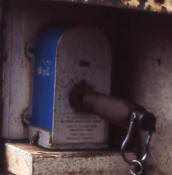 On 7-September-1970 the former
SR main line from
Bere Alston to St Budeaux (at Plymouth) was
reduced to single-track and the signal-box at Bere Alston was closed. Thereafter
there was a single One Train Working (OTW - formerly known as OES) section all
the way from the junction with the WR main line at St Budeaux
to Gunnislake, controlled by a new wooden train staff.
A new connection was made at the Plymouth end of Bere Alston station
between the lines to St Budeaux and Gunnislake and this is controlled by a 2-lever ground-frame
unlocked by an Annetts key on the train staff. Initially the OTW staff was held
at St Budeaux (Ferry Road) signal-box, but since that was closed on 2-July-1973
it has been kept in an Annetts key release instrument (seen here on the right in 2004) in a cabinet on the platform at St Budeaux (Victoria Road) station, from
which it is released electrically by the signalman at Plymouth panel. By the mid-1990s the
original OTW train staff had been replaced by a square, blue staff with 'B' configuration key,
and then it appears to have been superseded again by a round staff. A further change of
staff took place on 4-December-2005 (after the last train of the day), the new staff being
black with a square steel shaft.
On 7-September-1970 the former
SR main line from
Bere Alston to St Budeaux (at Plymouth) was
reduced to single-track and the signal-box at Bere Alston was closed. Thereafter
there was a single One Train Working (OTW - formerly known as OES) section all
the way from the junction with the WR main line at St Budeaux
to Gunnislake, controlled by a new wooden train staff.
A new connection was made at the Plymouth end of Bere Alston station
between the lines to St Budeaux and Gunnislake and this is controlled by a 2-lever ground-frame
unlocked by an Annetts key on the train staff. Initially the OTW staff was held
at St Budeaux (Ferry Road) signal-box, but since that was closed on 2-July-1973
it has been kept in an Annetts key release instrument (seen here on the right in 2004) in a cabinet on the platform at St Budeaux (Victoria Road) station, from
which it is released electrically by the signalman at Plymouth panel. By the mid-1990s the
original OTW train staff had been replaced by a square, blue staff with 'B' configuration key,
and then it appears to have been superseded again by a round staff. A further change of
staff took place on 4-December-2005 (after the last train of the day), the new staff being
black with a square steel shaft.
© CJL Osment 2002-19
Tablet photograph courtesy Richard Lemon, Calstock train staff and ticket box
photographs courtesy Mike Soden (Great
Central Railwayana Auctions), SR key token photograph courtesy Brian Janes (Colonel Stephens Museum), red OES staff photograph courtesy John Brodribb (SDR
Museum), St Budeaux instrument photograph courtesy Howard Sprenger, all
other photographs WCRA collection.